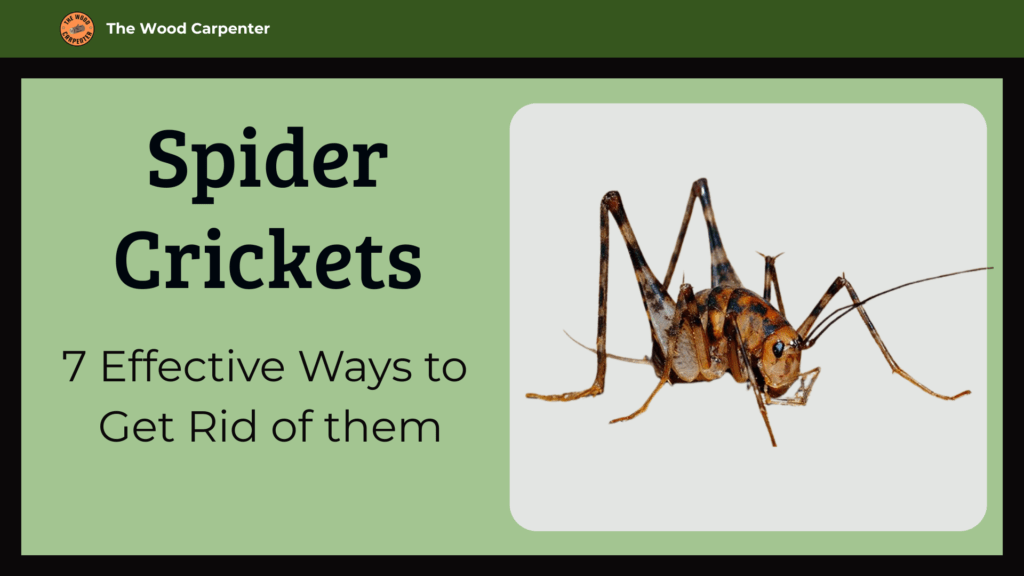
If you have ever gone down to your basement or your garage, only to be startled by a weird, humpbacked insect leaping straight towards you, then the chances are that you’ve met a spider cricket. Which is also called as camel crickets or cave crickets, these critters are not harmful in the way termites or carpenter ants are, but they can still make your home feel like something out of a horror movie.
The good news? You don’t have to live with them. And with the right combination of prevention and control measures, you can send these jump-crazy invaders packing. In this guide, I will show you 7 effective spider cricket killer remedies and how to prevent them from returning.
What Are Spider Crickets, Exactly?
Spider crickets aren’t spiders at all, despite their name. They’re bugs, closely related to grasshoppers and the true crickets, but with a humped back and very long legs that make them resemble a spider. They don’t chirp, like regular crickets do, and they are totally wingless.
Instead, they communicate and shield themselves by hopping — often right at you, which can be disconcerting. Although they don’t bite in a way that breaks skin, their delicate mandibles can nibble on fabric, paper, wood and even other insects, making them quite the nuisance when they end up inside.
They flourish in moist, dark places such as crawl spaces, basements, garages and sheds. And once they get comfortable, they multiply quickly.
They thrive in damp, dark spaces like crawlspaces, basements, garages, and sheds.
7 Effective Ways
So let’s dive into the seven best ways to get rid of spider crickets before they take over your home.
1. Seal Off Entry Points
Think of these spider crickets as opportunistic squatters— because they will take advantage of any of the crack, gap, or the hole that lets them inside. So start by doing a careful inspection around your home:
- Look for the gaps around windows, doors, vents, and foundation cracks.
- Use caulk, weather stripping, or expandable foam to seal these entryways.
- And do not ignore utility lines (plumbing and wiring often leave gaps through which pests can enter).
- By sealing your home tight, you won’t just keep spider crickets at bay — but also, ants, cockroaches and other rodents.
2. Reduce Clutter Indoors and Out
Spider crickets loves the clutter because it gives them the hiding spots and food sources. You might as well roll out the welcome mat if your basement resembles a graveyard for cardboard boxes.
Here’s what helps:
- Replace the cardboard boxes with a sealed plastic bins.
- Clear out the piles of fabric, old newspapers, and your unused furniture.
- Outside, move the woodpiles, leaf litter, and compost heaps away from your house.
When I assisted a friend in confronting a spider cricket infestation in her garage, my friend found dozens lurking under stacks of old magazines. Once we removed them, the cricket population fell by 3/4ths.
3. Control Moisture and Humidity
If you have moisture in your basement, that leads to an infestation of spider crickets. They thrive in moist environments — so the best thing you can do to fight them is to dry out your home.
- Run a dehumidifier in basements, crawlspaces, and laundry rooms.
- Keep humidity levels between 30–50%.
- Fix leaky pipes, dripping faucets, or poor drainage around your foundation.
- Make sure gutters and downspouts are working properly.
I had a basement that always smelled musty, and sure enough, spider crickets showed up every summer. It made the space drier when I installed a dehumidifier, and indirectly less attractive to them right away.
4. Use Sticky Traps
Sometimes the best tools are the simplest. Sticky traps (the kind used for mice, such as glue boards) can trap dozens of spider crickets overnight.
- Position them along walls, behind pieces of furniture or near appliances — anywhere you’ve spotted crickets hopping.
- Add a small piece of the moldy bread or your pet’s food as bait (they can’t resist it).
- After getting stuck, spider crickets may also attract fellow members of their species.
The method is cheap, nontoxic and surprisingly fast.
5. Try Soapy Water Traps
If you don’t want to buy traps, you can create a DIY cricket trap with a shallow bowl of soapy water.
Here’s how:
- Fill a shallow container (like a pie pan) with water.
- Add a few drops of dish soap.
- Set it up in the locations which spider crickets infest.
- They will jump in, get trapped, and drown because the soap breaks the water’s surface tension. And refresh the bowl every couple of days to get best results.
6. Sprinkle Diatomaceous Earth
For those who seek an all natural, yet very effective measure to take, diatomaceous earth (DE) is certainly worth trying. This fine powder comes from fossilized algae, and although it’s soft to us, it’s razorsharp to bugs.
- Put DE along baseboards, cracks, crawl spaces, and entrances.
- And as spider crickets scrabble across it, the powder tears at their exoskeleton and eventually dehydrates them.
- Just keep in mind: dry DE is more effective, so avoid damp places.
If you apply it correctly, it’s safe for people and pets, although you’ll probably want to wear a mask while applying it to avoid inhaling the dust.
7. Call in the Professionals
If you’ve tried everything and spider crickets are still ruling your basement, it might be time to bring in the experts. Pest control professionals have access to stronger treatments, including targeted insecticides that aren’t available to homeowners.
While chemicals should always be a last resort, they can help in severe infestations. Plus, professionals can spot entry points and moisture issues you may have overlooked.
Final Thoughts
Spider crickets are not harmful but many times are unwanted houseguests. Seal the cracks, declutter, control moisture and use traps or natural remedies like DE and you’ll reclaim your home in a few weeks with minimal trouble. And remember: the sooner you act, the easier it is to stop a small problem from becoming a full-blown infestation.
Frequently Asked Questions (FAQ)
1. Are spider crickets dangerous?
No. These insects do not bite, sting or consume blood in any form – however their droppings can damage fabrics, paper products and stain surfaces with their presence.
2. Why do spider crickets jump at me?
This behavior is likely their defense mechanism: when startled they leap randomly with no intent of harming anyone in particular.
3. Do spider crickets chirp like regular crickets?
No. Unlike the true crickets, these spider crickets are silent. They don’t have wings to make sound.
4. What do spider crickets eat?
They’ll eat fungi, cardboard, fabric, carpet, paper, wood and sometimes each other — especially when food is scarce.
5. Can I get rid of spider crickets without chemicals?
Absolutely. Sealing cracks, reducing humidity, setting traps, and using diatomaceous earth are all effective non-toxic methods.
6. Where are spider crickets most common?
They’re found all over, but especially in the damp basements, crawlspaces, and garages. In the U.S., they’re more common east of the Mississippi.
7. How long do spider crickets live?
Their lifespan is usually between 1–2 years, and they can reproduce quickly if conditions are right.

